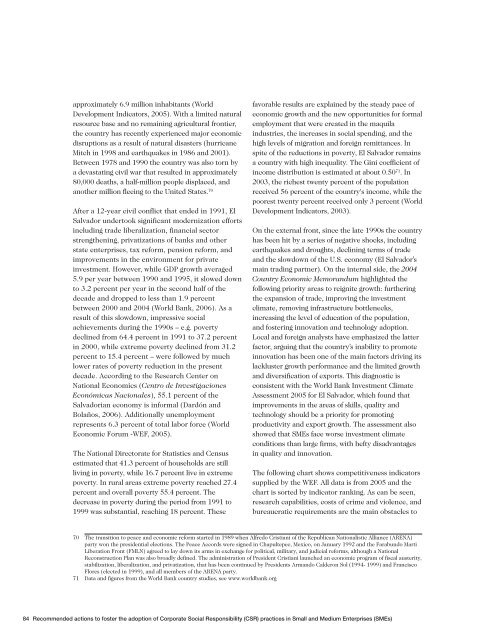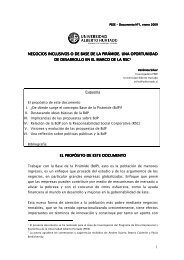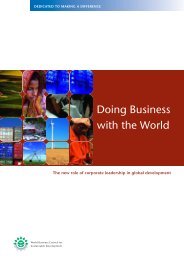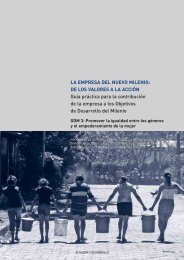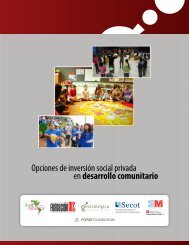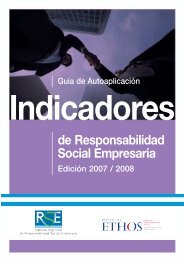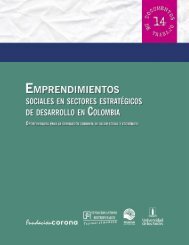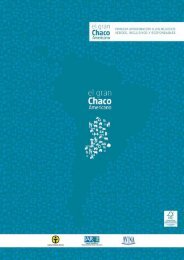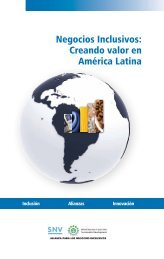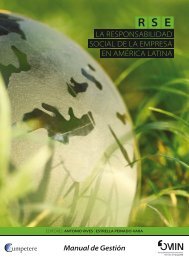Recommended actions to foster the adoption of Corporate Social ...
Recommended actions to foster the adoption of Corporate Social ...
Recommended actions to foster the adoption of Corporate Social ...
You also want an ePaper? Increase the reach of your titles
YUMPU automatically turns print PDFs into web optimized ePapers that Google loves.
approximately 6.9 million inhabitants (WorldDevelopment Indica<strong>to</strong>rs, 2005). With a limited naturalresource base and no remaining agricultural frontier,<strong>the</strong> country has recently experienced major economicdisruptions as a result <strong>of</strong> natural disasters (hurricaneMitch in 1998 and earthquakes in 1986 and 2001).Between 1978 and 1990 <strong>the</strong> country was also <strong>to</strong>rn bya devastating civil war that resulted in approximately80,000 deaths, a half-million people displaced, andano<strong>the</strong>r million fleeing <strong>to</strong> <strong>the</strong> United States. 70After a 12-year civil conflict that ended in 1991, ElSalvador under<strong>to</strong>ok significant modernization effortsincluding trade liberalization, financial sec<strong>to</strong>rstreng<strong>the</strong>ning, privatizations <strong>of</strong> banks and o<strong>the</strong>rstate enterprises, tax reform, pension reform, andimprovements in <strong>the</strong> environment for privateinvestment. However, while GDP growth averaged5.9 per year between 1990 and 1995, it slowed down<strong>to</strong> 3.2 percent per year in <strong>the</strong> second half <strong>of</strong> <strong>the</strong>decade and dropped <strong>to</strong> less than 1.9 percentbetween 2000 and 2004 (World Bank, 2006). As aresult <strong>of</strong> this slowdown, impressive socialachievements during <strong>the</strong> 1990s – e.g. povertydeclined from 64.4 percent in 1991 <strong>to</strong> 37.2 percentin 2000, while extreme poverty declined from 31.2percent <strong>to</strong> 15.4 percent – were followed by muchlower rates <strong>of</strong> poverty reduction in <strong>the</strong> presentdecade. According <strong>to</strong> <strong>the</strong> Research Center onNational Economics (Centro de InvestigacionesEconómicas Nacionales), 55.1 percent <strong>of</strong> <strong>the</strong>Salvadorian economy is informal (Dardón andBolaños, 2006). Additionally unemploymentrepresents 6.3 percent <strong>of</strong> <strong>to</strong>tal labor force (WorldEconomic Forum -WEF, 2005).The National Direc<strong>to</strong>rate for Statistics and Censusestimated that 41.3 percent <strong>of</strong> households are stillliving in poverty, while 16.7 percent live in extremepoverty. In rural areas extreme poverty reached 27.4percent and overall poverty 55.4 percent. Thedecrease in poverty during <strong>the</strong> period from 1991 <strong>to</strong>1999 was substantial, reaching 18 percent. Thesefavorable results are explained by <strong>the</strong> steady pace <strong>of</strong>economic growth and <strong>the</strong> new opportunities for formalemployment that were created in <strong>the</strong> maquilaindustries, <strong>the</strong> increases in social spending, and <strong>the</strong>high levels <strong>of</strong> migration and foreign remittances. Inspite <strong>of</strong> <strong>the</strong> reductions in poverty, El Salvador remainsa country with high inequality. The Gini coefficient <strong>of</strong>income distribution is estimated at about 0.50 71 . In2003, <strong>the</strong> richest twenty percent <strong>of</strong> <strong>the</strong> populationreceived 56 percent <strong>of</strong> <strong>the</strong> country's income, while <strong>the</strong>poorest twenty percent received only 3 percent (WorldDevelopment Indica<strong>to</strong>rs, 2003).On <strong>the</strong> external front, since <strong>the</strong> late 1990s <strong>the</strong> countryhas been hit by a series <strong>of</strong> negative shocks, includingearthquakes and droughts, declining terms <strong>of</strong> tradeand <strong>the</strong> slowdown <strong>of</strong> <strong>the</strong> U.S. economy (El Salvador’smain trading partner). On <strong>the</strong> internal side, <strong>the</strong> 2004Country Economic Memorandum highlighted <strong>the</strong>following priority areas <strong>to</strong> reignite growth: fur<strong>the</strong>ring<strong>the</strong> expansion <strong>of</strong> trade, improving <strong>the</strong> investmentclimate, removing infrastructure bottlenecks,increasing <strong>the</strong> level <strong>of</strong> education <strong>of</strong> <strong>the</strong> population,and <strong>foster</strong>ing innovation and technology <strong>adoption</strong>.Local and foreign analysts have emphasized <strong>the</strong> latterfac<strong>to</strong>r, arguing that <strong>the</strong> country’s inability <strong>to</strong> promoteinnovation has been one <strong>of</strong> <strong>the</strong> main fac<strong>to</strong>rs driving itslackluster growth performance and <strong>the</strong> limited growthand diversification <strong>of</strong> exports. This diagnostic isconsistent with <strong>the</strong> World Bank Investment ClimateAssessment 2005 for El Salvador, which found thatimprovements in <strong>the</strong> areas <strong>of</strong> skills, quality andtechnology should be a priority for promotingproductivity and export growth. The assessment alsoshowed that SMEs face worse investment climateconditions than large firms, with hefty disadvantagesin quality and innovation.The following chart shows competitiveness indica<strong>to</strong>rssupplied by <strong>the</strong> WEF. All data is from 2005 and <strong>the</strong>chart is sorted by indica<strong>to</strong>r ranking. As can be seen,research capabilities, costs <strong>of</strong> crime and violence, andbureaucratic requirements are <strong>the</strong> main obstacles <strong>to</strong>70 The transition <strong>to</strong> peace and economic reform started in 1989 when Alfredo Cristiani <strong>of</strong> <strong>the</strong> Republican Nationalistic Alliance (ARENA)party won <strong>the</strong> presidential elections. The Peace Accords were signed in Chapultepec, Mexico, on January 1992 and <strong>the</strong> Farabundo MartiLiberation Front (FMLN) agreed <strong>to</strong> lay down its arms in exchange for political, military, and judicial reforms, although a NationalReconstruction Plan was also broadly defined. The administration <strong>of</strong> President Cristiani launched an economic program <strong>of</strong> fiscal austerity,stabilization, liberalization, and privatization, that has been continued by Presidents Armando Calderon Sol (1994- 1999) and FranciscoFlores (elected in 1999), and all members <strong>of</strong> <strong>the</strong> ARENA party.71 Data and figures from <strong>the</strong> World Bank country studies, see www.worldbank.org84 <strong>Recommended</strong> <strong>actions</strong> <strong>to</strong> <strong>foster</strong> <strong>the</strong> <strong>adoption</strong> <strong>of</strong> <strong>Corporate</strong> <strong>Social</strong> Responsibility (CSR) practices in Small and Medium Enterprises (SMEs)


